
The injection of basaltic lava into surface water can be quiescent or highly explosive. Pahoehoe tends to pour into water in a passive manner, sometimes with little interaction beyond the boiling of water. More explosive interactions are generally associated with a'a flows. Water has a greater opportunity to penetrate into the cracks of a'a, where it expands explosively and fragments the lava into airborne particles. Littoral cones can develop at the water's edge from the accumulation of these airborne fragments.
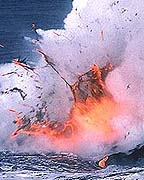 |
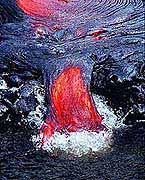 |
|
of lava and water |
of lava and water |
When basalt enters water passively, it forms pillow basalt. These are bulbous bodies with quenched, glassy rinds. They are often spherical, with diameters of 30-100 cm, although many are lobate. During formation, the outer surface of each lobe chills instantaneously. However, the constant injection of lava may cause a single lobe to swell, thus cracking the glassy rind, allowing a new lobe bud forth. Individual pillows can break off the budding lobe and cool as a single mass. As the interior of a pillow cools, it forms crude cooling joints that radiate inward, perpendicular to the cooling surface. Each pillow will settle into gaps between the pillows below it. In continental lakes, pillow accumulations can be several tens of meters thick, whereas those that develop on the ocean floors can be hundreds of meters thick.
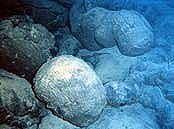 |
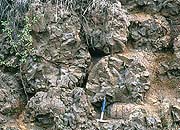 |
|
Pacific Ocean floor |
Columbia Plateau |
Quenching and fragmentation of basaltic lavas produces an accumulation of angular, glassy fragments called hyaloclastite. Basalt fragmentation can occur by the explosive eruption process, or by an essentially nonexplosive process associated with the spalling of pillow basalt rinds by thermal shock or chill shattering. The hyaloclastite fragments are equant, angular shards of black glass, generally between .25 and 2.0 cm in diameter . This water-quenched basalt glass is called sideromelane, a pure variety of glass that that is transparent, and lacks the very small iron-oxide crystals found in the more common opaque variety of basalt glass called tachylite. In hyaloclastite, these glassy fragments are typically surrounded by a matrix of yellow-to-brown palagonite, a wax-like substance that forms from the hydration and alteration of the sideromelane. A related hydrovolcanic deposit, called palagonite tuff, contains a mixture of sideromelane shards and coarser-grained fragments of basaltic rock in a palagonite matrix.
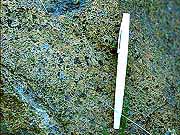 |
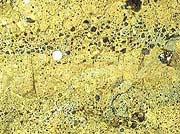 |
|
|
|
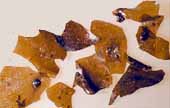 |
Limu o Pele - Recent hydrovolcanic basalt deposits may preserve paper-thin glassy fragments known as Limu o Pele (seawead of Pele). These form from the bursting of large glass bubbles generated by the rapid expansion of steam as lava interacts with seawater. These are not well-preserved in most ancient deposits. Courtesy of David Clague (copyrighted to MBARI). |
A variety of features can be generated by basaltic lava flowing over wet sediment. As lava advances over a wet spot, like a puddle, the resulting steam explosion can inject sediment into the interior of the flow. The sediment protrusion produced by this event is called a spiracle. If the steam explosion is large enough, it might generate an explosion tube through the entire flow. Similar explosion tubes are created by CO2 explosions above vegetated areas. Steam action can also produce clastic dikes. These features develop in fractures that act as conduits for the transport of sediment-carrying steam into the body of the lava flow.
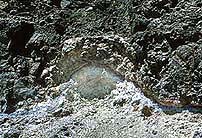 |
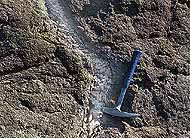 |
|
|
|
In some rare cases, the moving lava may mix with the wet sediment to produce peperite, a heterogeneous deposit composed of dark basalt fragments and light-colored sediment. The formation of peperites is not well understood, but they appear to be associated with the invasion of basalt into wet sediment, without significant explosion, but with at least some fragmentation of the basalt.
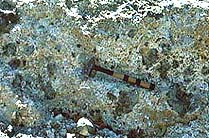 |
Peperite near Asotin, Washington |
Many basaltic rocks in the geologic record can be found sandwiched between two sedimentary rocks. If field evidence shows that the basalt cooled against both the sediment below and above, then it is typically classified as a shallow, near-horizontal intrusion called a sill. However, many workers on the Columbia River Flood Basalt Province have found that some of these sill-like bodies are not intrusions at all, but rather invasive lava flows. Although liquid, the basaltic lava has a higher density than the wet sediment. Thus,a basaltic flow on the surface of the earth will tend to burrow into an accumulation of wet sedimtent rather than flow above it.
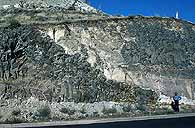
|
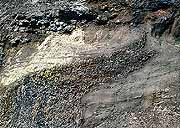
|
|
Lewiston, Idaho |
Orofino, Idaho |
As the head of the flow bulldozes into the deposit, the invasion is passive, with little disruption of the sediment. The sediment-lava contact is typically horizontal. Pillow-like structures are scarce, as are appendages of lava that protrude vertically into the overlying sediment. Unlike surface lavas, the upper surface of invasive flows is rarely vesicular, and is typically marked by a glassy selvage due to rapid cooling against the overlying sediment. It may be that the geologic record contains many invasive lavas that have previously interpreted as basaltic sills.
For a seperate discussion on the role of external water in the eruptive process, see HYDROVOLCANIC ERUPTIONS.